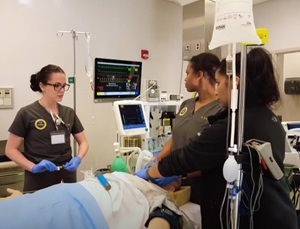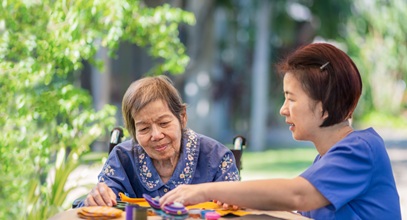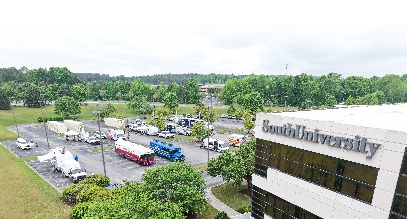 At South University, our Master of Science in Anesthesia Science program prepares graduates to deliver anesthesia care to patients of all ages across a complete spectrum of illnesses and health issues.1 In addition to classroom learning and clinical experiences, the program includes hands-on training inside a mock OR (operating room) and anesthesia learning labs. These healthcare simulations let students put their knowledge to the test and act as an anesthesiologist assistant does in the OR.
At South University, our Master of Science in Anesthesia Science program prepares graduates to deliver anesthesia care to patients of all ages across a complete spectrum of illnesses and health issues.1 In addition to classroom learning and clinical experiences, the program includes hands-on training inside a mock OR (operating room) and anesthesia learning labs. These healthcare simulations let students put their knowledge to the test and act as an anesthesiologist assistant does in the OR.What is a simulation lab?
A simulation lab is a controlled, realistic environment where students can practice clinical skills, decision-making, and patient interactions without the risks associated with real-life situations. At South University, our simulation labs feature high-fidelity mannequins, computer technology, and simulated medical equipment. Our labs can replicate clinical scenarios from routine to emergency procedures.
What are the benefits of simulation labs?
Simulation labs allow students to apply theoretical knowledge in a safe setting. These experiences help students increase confidence and critical thinking. Students also learn from mistakes without endangering patients.
“Our goal here at South is for students to learn content in the classroom, practice it in the lab, apply it in simulation, and then be prepared for the clinic,” explains Amy Scroggin, Assistant Program Director and Professor in the Master of Medical Science in Anesthesia Science program at South University, Savannah. Amy is a Certified Anesthesiologist Assistant (CAA), Certified Healthcare Simulation Educator (CHSE), and practicing clinician. She is also a 2014 graduate of the program in which she teaches.
Simulation is such a critical part of health care training,” she shares. “Students can go in and see a clinical problem in a controlled environment, work through their case, and then have a lengthy debriefing.”
What happens in an Anesthesia Science simulation?
Our Anesthesia Science students enter the simulation lab in small groups. They receive information about their patient and their needs, as they would in a healthcare setting. Meanwhile, their instructor controls the simulator with a computer from a nearby room.
During the simulation, students run the case as a team and work through complex concepts they learned in class and practiced in the lab. “Our goal is to challenge them a little bit. Nothing's ever going to go perfectly well in simulation,” Amy shares.
The simulations vary widely. For example, the instructor may assign students a patient with a broken femur. As soon as the students walk into the lab, the simulation begins. Through the microphone, the instructor speaks. “Oh my goodness, I'm so glad you're here. My leg is killing me. I want to be asleep right now! Can you put me to sleep?” they say.
Such simulations give students a chance to not only work through the clinical aspects of what’s happening and make decisions on things like drug choice, dosage, and airways but also to practice patient communication. As students respond to the situation, the instructor watches and can adjust the simulation to see how they react to various outcomes.
What happens after a simulation ends?
Our instructors record everything that happens inside the simulation lab so that students can learn from what happened. “If they make a mistake, it's okay because then we can watch it back in debriefing. We can talk about it. We draw on the whiteboard. We have open discussion,” Amy says. “They're able to say, ‘Okay, now that makes more sense and I'm not going to make that mistake again.’”
This discussion takes place as part of a debriefing after the simulation is over. During the debriefing, the students and instructor watch the video together. They pause at critical moments, discuss each action, and zoom in on specific details, reviewing the choices made during the simulation. Students explain their reasoning and discuss what alternatives might have been better. By applying their knowledge in this mock clinical setting and then analyzing their work, students become better prepared for future clinical practice.
Interested in the anesthesia field?
Learn how studying Anesthesia Science at South University could prepare you to become an anesthesiologist assistant!1
1 South University does not promise or guarantee licensure, employment, or salary amounts.
Graduates are required to sit for and pass the national certification exam and obtain a state license in order to work in the field. (Exam names vary by program) Please refer to the State Professional Licensure Determination and National Certification/Licensure section of the University catalog for program and state specific information. South University cannot guarantee each graduate will pass the required licensure examinations. Outside agencies control the requirements for taking and passing certification/licensing exams and are subject to change without notice to South University. Students must pass the required licensure to work in their respective field.




